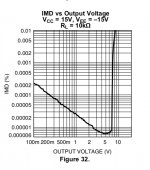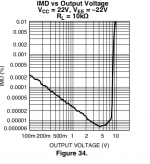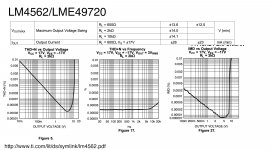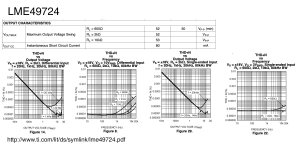0.000007% IMD is a disaster? HA! You're a funny person. Did you even look at the plot you included with Post #172?
Mike, why are you playing these games? Is it your yearly ritual of peeing on others, or do you seriously believe it reflects well on your business?
Tom
@10 volts its 0.00007%? It shoots to the moon at 8V! By 10 volts it's off the chart!
Why is it that it's assumed Mike is behind every intelligent question asked around here? You really must not have much faith in your followers. To assume they will also look at the chart and see what you just said.
Last edited:
I'm so tired of audio manufacturers who exploit the ignorance of their clients by twisting numbers around. I've seen it so many times. They can have a chart right in front of their eyes proving something is amiss. But if fanboy's of the manufacturer show up, they turn a blind eye and pretend the data isn't real. Then they all dog pile on the guy who exposed the truth. It's just down right wrong.
Yes I know who Mike is. Yes I've chatted to him on several occasions. He's the only guy who was going to offer a SOTA buffer board for the Purifi modules to the DIY community. But it's crap like we have witnessed over the last 2 days on this thread, and the Purifi thread that made him give up on the DIY community. Obviously it's all a case of extreme jealousy that he used to be a fellow DIYer on this forum, but went on to be a huge success. When the same guys are all still here doing the same old thing. And with that I'm also done here. Have a good life!
Last edited:
@10 volts its 0.00007%? It shoots to the moon at 8V! By 10 volts it's off the chart!
Yes. The IMD degrades as the amp enters clipping. Any amp does that.
As for your other grievances: I'm tired of trolls taking up my time. As I asked you in Post #118: Will you allow me time to perform the measurements, or is your intent to continue to spread fear, uncertainty, and doubt about my products?
If my products don't live up to your requirements or expectations, that's fine. Just move on. Unlike the vast majority of manufacturers out there, at least I make the data available so you can make an informed choice.
And with that I'm also done here. Have a good life!
Sounds great. You too. Thanks for stopping by.
Tom
Last edited:
Considering the purifi offers a differential input requiring 10vrms at 4K ohms for full output, it would be good to consider that:
- the relevant datasheet is mostly the lme49724;
- no lm4562 in Tom's buffer is required to swing 20Vp-p, far from it.
I see no reason why this buffer would be unsuitable as input buffer for the purifi.
- the relevant datasheet is mostly the lme49724;
- no lm4562 in Tom's buffer is required to swing 20Vp-p, far from it.
I see no reason why this buffer would be unsuitable as input buffer for the purifi.
I see no reason why this buffer would be unsuitable as input buffer for the purifi.
I don't either. In fact, I just included the gain resistor value for 13.4 dB gain in the design doc. This value will allow you to get a total gain of 26 dB with the Hypex NC500 and the Purifi 1ET400A.
Tom
I don't either. In fact, I just included the gain resistor value for 13.4 dB gain in the design doc. This value will allow you to get a total gain of 26 dB with the Hypex NC500 and the Purifi 1ET400A.
Tom
Perfect it will only take 1.7v input from the source to drive the buffer into IMD clipping. 1.6v before the amp module reaches full power. Great setup. Maybe I'll reconsider.
Last edited:
Considering the purifi offers a differential input requiring 10vrms at 4K ohms for full output, it would be good to consider that:
- the relevant datasheet is mostly the lme49724;
- no lm4562 in Tom's buffer is required to swing 20Vp-p, far from it.
I see no reason why this buffer would be unsuitable as input buffer for the purifi.
Yes my mistake you're right the differential input impedance is 4.4K. But even at 10K input impedance the IMD plot shows clipping at just under 8 volts. We need 9.6 volts to drive the amp to full power.
And it's the LM4562 that will be handling the role. Tom said so himself earlier in the thread.
Attachments
Last edited:
10Vrms means 28V p-p. That means hot and cold must each swing 14Vp-p, which would translate to 7V in your datasheet. Why 9.6V ?
If the output lme49724 is set at unity gain, that's the worst case scenario.
The only (completely theoretical and unpractical) problem I can imagine is in SE to BAL mode, if everything is set to unity gain, as you would in principle need 10Vrms at only one input of the lme49724 and a lm4562 would need to provide that. But I haven't fully reverse engineered the circuit so Tom will have to weight in on that.
PS: I have zero business with Neurochrome, I just like technical stuff to be accurate.
If the output lme49724 is set at unity gain, that's the worst case scenario.
The only (completely theoretical and unpractical) problem I can imagine is in SE to BAL mode, if everything is set to unity gain, as you would in principle need 10Vrms at only one input of the lme49724 and a lm4562 would need to provide that. But I haven't fully reverse engineered the circuit so Tom will have to weight in on that.
PS: I have zero business with Neurochrome, I just like technical stuff to be accurate.
Hi all, I’m cischico living out in Japan. I been reading this thread and some other threads in another forum and keep hearing about this guy named Tom. Anyways as I understand the neurochrome universal buffer can work with the Purifi module as it is currently sold. I just want to make sure I did misunderstand that Tom may be making another one specifically for the Purifi module.
Thanks for the knowledge and taking the time to share and talk about it.
Thanks for the knowledge and taking the time to share and talk about it.
I honestly cannot get to grips with sonic bliss's problem with the specifications of the devices. Right in the introduction to the datasheet it says "Further, dynamic range is maximized by an output stage is capable of driving 2k loads to within 1V of either power supply voltage, and to within 1.4V when driving 600 ohm loads"
So with 17V rails, it can drive to 16V into 2k load, which is 11.3V rms. Which the harmonic distortion curves confirm.
With IMD, and keeping the two tones the same amplitude as the single tone harmonic test, the overall amplitude is increased by root2, so you have to reduce the amplitude to keep the op amp out of clipping. Which - wait for it - by root2. So 11.3/root2 = 8V
Again confirmed in the datasheet.
In any event, the Purifi data is that you need 9.6V rms sine wave to drive the amp to 1% THD. At the point the 4562 will be producing 0.0001% absolute maximum THD
What's difficult?
So with 17V rails, it can drive to 16V into 2k load, which is 11.3V rms. Which the harmonic distortion curves confirm.
With IMD, and keeping the two tones the same amplitude as the single tone harmonic test, the overall amplitude is increased by root2, so you have to reduce the amplitude to keep the op amp out of clipping. Which - wait for it - by root2. So 11.3/root2 = 8V
Again confirmed in the datasheet.
In any event, the Purifi data is that you need 9.6V rms sine wave to drive the amp to 1% THD. At the point the 4562 will be producing 0.0001% absolute maximum THD
What's difficult?
Last edited:
As I read the Purifi datasheet, the balanced input impedance is 4.4k Ohms. Thus knowing distortion into 600 Ohms appears to be unnecessary to determine suitability as a front end for the Purifi.
As a suggestion that Tom can comment on, there is a variant on the LM4562/LME49720 called the LME49860 which will support +/-22V supplies and thus give higher maximum voltage outputs. Perhaps this will 'play well' with Tom's current PCB design and give the output performance needed.
As a suggestion that Tom can comment on, there is a variant on the LM4562/LME49720 called the LME49860 which will support +/-22V supplies and thus give higher maximum voltage outputs. Perhaps this will 'play well' with Tom's current PCB design and give the output performance needed.
As I read the Purifi datasheet, the balanced input impedance is 4.4k Ohms. Thus knowing distortion into 600 Ohms appears to be unnecessary to determine suitability as a front end for the Purifi.
As a suggestion that Tom can comment on, there is a variant on the LM4562/LME49720 called the LME49860 which will support +/-22V supplies and thus give higher maximum voltage outputs. Perhaps this will 'play well' with Tom's current PCB design and give the output performance needed.
Why would the opamp need changed out when Tom has already stated that the current board as is, is perfect for the application of driving the Purifi amp? Are we finally coming to the conclusion that it isn't?
In any event, the Purifi data is that you need 9.6V rms sine wave to drive the amp to 1% THD. At the point the 4562 will be producing 0.0001% absolute maximum THD
What's difficult?
Nobody was claiming THD was a problem.
It's easy to get lost in the many graphs in the LME49724 and LM4562/LME49720 data sheets, so I've created some "summary figures". I chose the ±17-18 V supply, 2 kΩ load operating point as that is the most relevant for the Universal Buffer when driving the Purifi 1ET400A. The Purifi has 4.4 kΩ input impedance, but TI does not provide data for that operating point. As 2.0 kΩ is a heavier load, the data point I chose will show slightly worse performance than what I would expect from the Universal Buffer when driving a Purifi 1ET400A.
Purifi says 9.6 V RMS is needed to drive the 1ET400A to clipping (450 W, 1% THD, 4 Ω load). So by golly we must provide it! 🙂
With a differential input, each half of the signal pair drives half the voltage. So each LM4562/LME49720 that buffers the signal into the LME49724 must provide 9.6/2 = 4.8 V RMS. As you can see in attached graphs, the LM4562/LME49720 can easily provide 4.8 V RMS cleanly and the LME49724 can easily and cleanly provide the resulting 9.6 V RMS differential output.
So clearly, the Universal Buffer is perfectly capable of cleanly driving the Purifi 1ET400A to clipping. The THD/IMD/sound quality will be limited by the Purifi and not the Universal Buffer. That's exactly what you want.
Exactly! With a single-ended input and unity gain, now one LM4562/LME49720 provides 0 V (its input is grounded to the RCA shell), so now the other must make up the difference and provide 9.6 V RMS. That is right at the onset of clipping for the LM4562/LME49720, so it will "only" provide a bit better than 0.0001% THD. That's still four orders of magnitude (10000x) lower than the 1% you'd get from the Purifi 1ET400A at that point. And, as you can tell from the LME49724 data sheet, the LME49724 happily provides a clean 9.6 V RMS output even with a single-ended source.
I see. So you are working on reverse-engineering it? 🙂 😉
You certainly do a wonderful job at keeping me honest. It's been fun (although sometimes a little unnerving) to watch how you apply the knowledge you've picked up from me (and others too, presumably). Some might even argue that we're kinda-sorta-but-not-really competitors. I'm fine with that. There's plenty of room for both of us. 🙂
I'm still enjoying the Phil Colins, "Plays Well With Others" compilation that you sent me for Christmas in 2018, by the way. Thank you. In particular Disc 3 gets a regular spin around here.
It's rare that I quote a full post, but in this case it's well warranted. I couldn't have said it better myself.
Tom
10Vrms means 28V p-p. That means hot and cold must each swing 14Vp-p, which would translate to 7V in your datasheet. Why 9.6V ?
Purifi says 9.6 V RMS is needed to drive the 1ET400A to clipping (450 W, 1% THD, 4 Ω load). So by golly we must provide it! 🙂
With a differential input, each half of the signal pair drives half the voltage. So each LM4562/LME49720 that buffers the signal into the LME49724 must provide 9.6/2 = 4.8 V RMS. As you can see in attached graphs, the LM4562/LME49720 can easily provide 4.8 V RMS cleanly and the LME49724 can easily and cleanly provide the resulting 9.6 V RMS differential output.
So clearly, the Universal Buffer is perfectly capable of cleanly driving the Purifi 1ET400A to clipping. The THD/IMD/sound quality will be limited by the Purifi and not the Universal Buffer. That's exactly what you want.
The only (completely theoretical and unpractical) problem I can imagine is in SE to BAL mode, if everything is set to unity gain, as you would in principle need 10Vrms at only one input of the lme49724 and a lm4562 would need to provide that.
Exactly! With a single-ended input and unity gain, now one LM4562/LME49720 provides 0 V (its input is grounded to the RCA shell), so now the other must make up the difference and provide 9.6 V RMS. That is right at the onset of clipping for the LM4562/LME49720, so it will "only" provide a bit better than 0.0001% THD. That's still four orders of magnitude (10000x) lower than the 1% you'd get from the Purifi 1ET400A at that point. And, as you can tell from the LME49724 data sheet, the LME49724 happily provides a clean 9.6 V RMS output even with a single-ended source.
But I haven't fully reverse engineered the circuit so Tom will have to weight in on that.
I see. So you are working on reverse-engineering it? 🙂 😉
PS: I have zero business with Neurochrome, I just like technical stuff to be accurate.
You certainly do a wonderful job at keeping me honest. It's been fun (although sometimes a little unnerving) to watch how you apply the knowledge you've picked up from me (and others too, presumably). Some might even argue that we're kinda-sorta-but-not-really competitors. I'm fine with that. There's plenty of room for both of us. 🙂
I'm still enjoying the Phil Colins, "Plays Well With Others" compilation that you sent me for Christmas in 2018, by the way. Thank you. In particular Disc 3 gets a regular spin around here.
I honestly cannot get to grips with sonic bliss's problem with the specifications of the devices. Right in the introduction to the datasheet it says "Further, dynamic range is maximized by an output stage is capable of driving 2k loads to within 1V of either power supply voltage, and to within 1.4V when driving 600 ohm loads"
So with 17V rails, it can drive to 16V into 2k load, which is 11.3V rms. Which the harmonic distortion curves confirm.
With IMD, and keeping the two tones the same amplitude as the single tone harmonic test, the overall amplitude is increased by root2, so you have to reduce the amplitude to keep the op amp out of clipping. Which - wait for it - by root2. So 11.3/root2 = 8V
Again confirmed in the datasheet.
In any event, the Purifi data is that you need 9.6V rms sine wave to drive the amp to 1% THD. At the point the 4562 will be producing 0.0001% absolute maximum THD
What's difficult?
It's rare that I quote a full post, but in this case it's well warranted. I couldn't have said it better myself.
Tom
Attachments
Even the LME49860 driven from +-22v rails into a 10k load doesn't cut it.
Once more:
With IMD, and keeping the two tones the same amplitude as the single tone harmonic test, the overall amplitude is increased by root2, so you have to reduce the amplitude to keep the op amp out of clipping. Which - wait for it - by root2. So 11.3/root2 = 8V
Read. Comprehend. It's a skill.
What's difficult?
Reading and comprehension, apparently. Or maybe accepting that there's a well-engineered, well-tested, and well-documented $149 Universal Buffer available that will outperform the Envy-of-the-World Buffer that requires a $1k deposit (non-refundable, I'm sure) just to read about?
Tom
Just saw this. Nicely done sawyers, 00940, Brian L and of course Tomchr in delineating the situation (which really isn't one as anticipated). I hate to say it but understanding the differences between Vrms, Vp and Vp-p is basic electrical engineering period.
I think I just heard the toilet flush. We have just exorcised the demon. This room is clear.
Best,
Anand.
I think I just heard the toilet flush. We have just exorcised the demon. This room is clear.
Best,
Anand.
Impressive smoke screen that should sell everyone on the performance. But unfortunately it will not change the 10V RMS IMD performance into 600R- 10K loads. No matter how confused you make the laymen. Let alone the sound quality of the IC's once they enter class A/B mode. Which doesn't take much. Why anyone who wants a cheap IC buffer wouldn't just stick with what's on the stock Purifi board already is beyond me. They even provide a proper Bruno Putzeys designed discrete voltage regulator to drive them for free.
Last edited:
- Home
- Vendor's Bazaar
- Universal Buffer achieving -140 dBc (0.00001 %) THD




